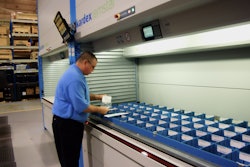It is that time of year again. The days are getting longer, the temperature is getting warmer and people are getting the urge to shake off the last vestiges of winter mustiness.
Time to open up the window to let in fresh air and open up the door to let out some things that are accumulating dust. Items that were needed at a time, but are no longer relevant — clothes that no longer fit, books that won’t be read and tools that will never be used. How was all of that stuff accumulated? It is time for…spring cleaning!
Just as you do spring cleaning at home, you might want to consider doing so at work as well. How many items do you have in your tool crib, janitorial closet, pigeonhole bins in the maintenance area and squirreled away in who know what other places? At the time, it no doubt seemed like a good idea to buy those items, but now you may struggle to remember the reason. All you know is that they have somehow, someway taken over.
Likely, there are a couple reasons you have all of that inventory on-hand:
First, some things are so inexpensive that it seems to take more time to place the order than it does to simply buy an excess amount (nuts and bolts, office supplies, toilet paper). You don’t want to send someone out shopping and handle another purchase card transaction, or cut a purchase order each time you needed one of any of those items.
Second, you likely have items on hand that you can’t do without when it is needed (replacement motor, belts). But when was the last time you needed those items? Do they still work? Do you still have the machine they go on? Have you revamped the color scheme and are no longer using that paint? All of the excess inventory takes up valuable space, time to manage and money — money that could be better invested in critical, value-added products, work or opportunities.
Many times, inventory is accumulated, but not accounted for consistently, so it’s difficult to know what’s there. It often becomes a guessing game. In fact, it is fairly common for organizations to lack clear visibility to their inventory. While it is often possible to identify what has been purchased and when, it is much more difficult to know where those products are, if they have been used, how many, by whom, when or for what job.
This lack of clarity leads to increased cost and decreased productivity. It also can lead to overstocking in the belief that “more is better.” However, sometimes more is just more, in terms of the time it takes to dig through inventory to find what you need to get back to the task at hand.
A Grainger study shows that up to 50 percent of products used to maintain, repair or operate facilities have not moved during a 12-month period. This can be the result of several things, such as changes to the production line or the equipment used, so these items have become outdated. It also can be due to organizations keeping critical items on hand, which isn’t so bad — as long as they don’t keep too many, can find them when needed and they have not deteriorated over time. Whatever the reason, inactive inventory consumes a lot of money in terms of the purchase price, storage space and time to manage. Managing inventory successfully means saving time, money and space. It also means eliminating the need for an annual ritual of spring cleaning.
At its core, inventory management is tracking the items needed to keep your operations running, while maintaining the delicate balance of supply and demand. The goal is to assure that you have the right product in the right place at the right time, without overstocking or understocking, and doing so with as little effort and expense as possible. Not always an easy task!
When it comes to stocking your inventory, it is common to focus on the convenience (toilet paper) and insurance (replacement motor) of having the items on hand in case you suddenly need them. However, stocking these items can tie up a significant investment in terms of the cost of purchasing the items (money now not available for other needs), space (that could be used for other revenue-generating activity) and time (shopping, putting away, and finding those items). There is that balance again!
In general, we see two basic approaches to managing that inventory: Simple Replenishment and True Inventory Management.
Using a Simple Replenishment model, companies estimate what they think they need in stock for a given time period, and reorder when they get close to running out. There is risk to that, since we know it is easy to miscalculate. And, if the needed items are in that “I may need this someday” stockpile, can it be easily found? These challenges can lead to potentially shutting down the line and revenue stream.
Think of it this way — through research done by Grainger, we learned from the companies studied that 22 percent of the time, employees cannot find what they’re looking for, because it is in the wrong place, or just lost in the clutter. That translates into wasted money and space, plus additional work when it comes to spring cleaning whether you relate that to the clutter at home or at work.
An alternative approach seen at best in class organizations is True Inventory Management — actively monitoring and measuring use and inventory levels on a regular basis, and making adjustments based on planning. This requires an organization to use a data-driven approach (through bar coding, mobile or dispensing machines) to determine what’s stocked and what’s consumed, and analyze and adjust accordingly. Through this approach, organizations find they can reduce their investment in inventory and still know that they have the right items where they are needed when they are needed.
So, if you are thinking about, or already starting on your spring cleaning at home or at work, consider how inventory management can reduce that task moving forward.
Patricia Julius is a manager on Grainger’s Inventory Management Team.























